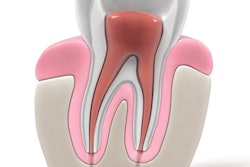
Laser fluorescence may effectively detect initial caries progression, but the technology struggles at monitoring later, more minute changes, according to a new study that looked at enamel demineralization with three different tools.
Although laser fluorescence has been readily studied, the results have been mixed. Therefore, a team of international researchers decided to use a new method to test the technology's effectiveness. They published their findings in Lasers in Medical Science (July 2, 2017).
"The aim of this study was to evaluate the performance of a pen-type laser fluorescence device to detect and monitor the progression of caries-like lesions on smooth surfaces," the study authors wrote. Laser fluorescence was "effective in detecting the first demineralization on enamel; however, the method did not show any effect in monitoring lesion progression after three cycles of in vitro demineralization," they added.
The study was led by Jonas Rodrigues, Dr med dent, PhD, from the department of pediatric dentistry at the Rio Grande do Sul Federal University School of Dentistry in Brazil. His co-authors were from the university's department of public health; the Cruzeiro do Sul University School of Dentistry, also in Brazil; and the University of Bern School of Dental Medicine in Switzerland.
LFpen effective in some cases
The Diagnodent LFpen (KaVo) uses laser fluorescence to detect caries. It emits a red light and captures the fluorescence emitted by oral bacterial on demineralized dental tissues.
Some studies have found that the pen can effectively detect caries in at least some cases, but others have shown that it can be prone to false positives and recommend using the technology as an adjunct tool to visual screening. The authors of the current study, therefore, decided to put the Diagnodent LFpen to the test using a different technique than in other studies.
For their in vitro experiment, the researchers began by cleaning bovine incisors and cutting them into square enamel blocks. They covered a portion of each block with nail varnish to protect against caries progression and serve as a reference point.
The researchers ended up with 52 blocks that they ran through two demineralization cycles, which consisted of soaking the blocks in a solution with Streptococcus mutans, Lactobacillus casei, and Actinomyces naeslundii for 48 hours. They also subjected half of the blocks to a third demineralization cycle.
The investigators measured laser fluorescence with the LFpen, demineralization with spectroscopy, and surface microhardness (HMV-2T, Shimadzu) at the start of the experiment and after each of the demineralization cycles. They used the three techniques to provide a more thorough picture of the caries progression, the authors noted.
After comparing demineralization across the three types of measurements, the researchers found that the Diagnodent LFpen could only effectively detect changes after the first cycle. The pen may be effective for surface measurements but not beyond that, the authors noted.
"Considering the LFpen values ... a significant increase in fluorescence values was found only after the first cycle," they wrote. "This shows that the method was effective to detect and quantify the initial demineralization of the enamel blocks. However, when the blocks were submitted to the second and third cycles, simulating the process of lesion progression, the LFpen was not effective for monitoring lesions in a stage previous to cavitation."
| Mean analysis of variance for superficial microhardness and LFpen | ||||
| Baseline | 1st cycle | 2nd cycle | 3rd cycle | |
| Superficial microhardness | 320.25 | 80.49* | 39.82* | 29.77* |
| Diagnodent LFpen | 4.31 | 7.58* | 7.16 | 5.10 |
The researchers also tested the reproducibility of their method and found "excellent agreement between the examiner measurements in each period," so that future researchers can see if their results vary, such as what has happened in previous studies of laser fluorescence technology.
Study strengths and weaknesses
This was one of many studies that has evaluated the Diagnodent LFpen as a caries detection tool. The authors noted that most existing in vitro studies use periods of chemical cycling to wear down tooth structures, which they worried did not accurately simulate the oral environment. Instead, they opted for a model that stored tooth samples in bacteria, a technique they considered a strength of their study.
“The LFpen was effective in detecting the first demineralization in the enamel.”
"An in vitro model that uses bacterial biofilm would be more representative than the chemical experimental models since dental caries is a multifactorial disease," they wrote. "Moreover, the LFpen detects changes in organic tooth content, such as fluorophores and other chromophores produced by cariogenic bacteria. Thus, the induction model of caries-like lesion used in this study seems closer to clinical reality."
However, because they conducted an in vitro study, the clinical applications of their findings may not be as relevant, and the authors cautioned against using the Diagnodent LFpen to measure minute changes.
"The LFpen was effective in detecting the first demineralization in the enamel; however, the method did not show any effect in monitoring enamel lesion progression after three cycles of demineralization," the authors concluded. "These findings indicate the LFpen does not accurately measure small changes in mineral content."



















